In the race of artificial intelligence (AI), it’s not just about having models that work. It’s about building an environment where AI works for you – with confidence, clarity, and domain awareness. This article shows how Graphwise helps you create AI systems that you can trust through AI-ready graph environments.
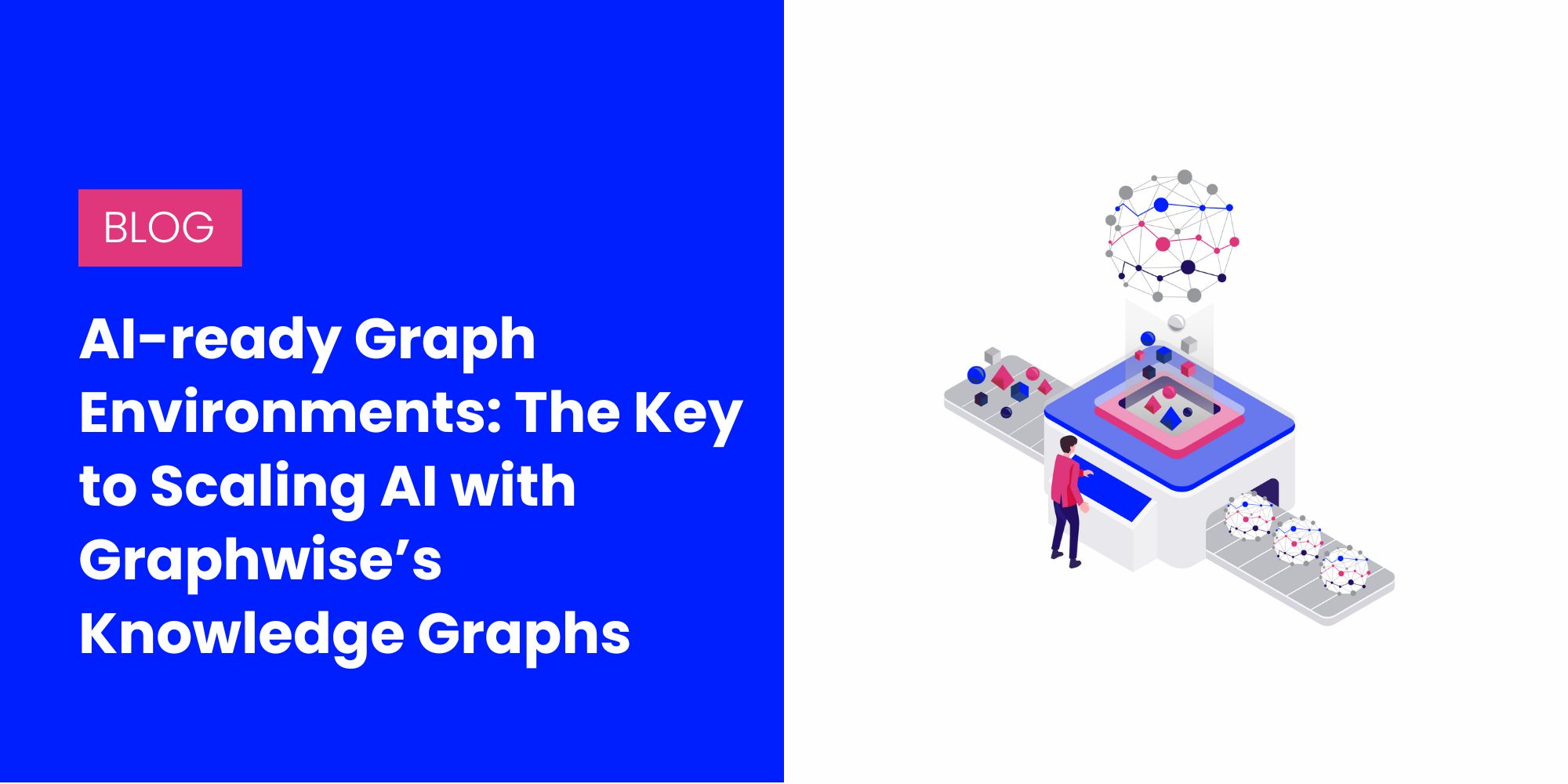
Is your AI making decisions you can’t trust? You are not alone. Many others are in the same boat. Nearly 80% of enterprise AI initiatives fail, which is a rate twice that of other tech projects. The main issue isn’t the AI models or a lack of ambition, but rather that their data isn’t ready for use, as it is siloed, fragmented, and disconnected from the real business context.
Without a strong data foundation, even advanced AI models, such as large language models (LLMs), can’t function effectively. Generative AI may produce fluent outputs, but if appropriate data is not provided, these outputs can be hallucinations — confident but false outputs — rather than valuable insights. According to Gartner, 59% of chief information officers (CIOs) identify AI hallucinations as a primary risk in generative AI.
Graphwise solves this at the root. It connects your enterprise data into a single, contextualized knowledge graph. It builds an environment that grounds your LLM in business reality. The result is AI that understands your domain, drives decisions you can trust, and delivers outcomes that matter.
The AI failure crisis: Why most enterprise AI fails
While there is considerable excitement surrounding AI, many businesses investing in AI projects struggle to achieve reliable results. This is because the data these projects use isn’t prepared or appropriately shared. AI can only drive productivity when it has access to integrated and connected data across the enterprise. However, only about 27% of enterprise apps data is connected on average, and 95% of IT leaders say that integration issues are blocking AI adoption.
Here’s why so many AI projects fail:
- Data fragmentation — Data fragmentation is one of the most persistent barriers to AI success, the dispersion of data across multiple locations or systems. Fivetran’s survey shows that 42% of enterprises’ AI initiatives underperform due to poor data readiness. Additionally, 68% of organizations with less than half of their data centralized experience revenue losses. This siloed data prevents AI models from understanding a business domain, resulting in reduced performance and incomplete or inaccurate insights.
- The hallucination problem — Another concerning issue is hallucination, where AI models produce believable but false information. These fabrications lead to misinformed decisions, erode trust, and even expose organizations to compliance risks. The primary reason for hallucination is that AI models lack access to accurate and context-specific company knowledge. As a result, they have to guess or infer based on their general training data.
- The generic AI trap — Off-the-shelf AI models are trained on general internet data. Without domain-specific grounding, these models often misinterpret terminology, fail to reflect business logic, and produce outputs that cannot be trusted for mission-critical decisions. So, you need AI that understands your specific business domain — called Domain-Aware AI, rather than using the same generic AI as everyone else.
What makes a graph environment AI-ready
An AI-ready graph environment addresses the challenges of data fragmentation and AI hallucinations by transforming raw, disparate enterprise data into connected, contextual intelligence, unified within a single semantic layer.
Central to the graph environment are knowledge graphs. They connect all your enterprise data by representing information as a network of entities (nodes) and their relationships (edges) within a graph database, such as Graphwise’s GraphDB. Knowledge graphs show the relationships and context between diverse data points, whether they originate from structured databases, unstructured documents, or live data streams. Knowledge graphs enhance AI by integrating domain knowledge and diverse data, addressing hallucinations, and boosting AI model accuracy through reasoning.
Building upon knowledge graphs are semantic layers. These layers infuse business logic into the connected data, making it meaningful to graph retrieval augmented generation (GraphRAG) and AI applications. Semantic layers use domain knowledge models, including ontologies, taxonomies, and vocabularies, to define the meaning of data elements and their relationships.
- Ontologies are formal definitions of entities, classes, properties, and rules that structure your domain knowledge.
- Taxonomies provide hierarchical classifications that organize concepts for easier retrieval, while vocabularies specify particular terms.
The architectural pattern for using this intelligence is through Graph Retrieval Augmented Generation. They address generic answers, lack of transparency, outdated or biased information, privacy and security issues, and hallucinations by grounding your AI models in quality data and knowledge models.
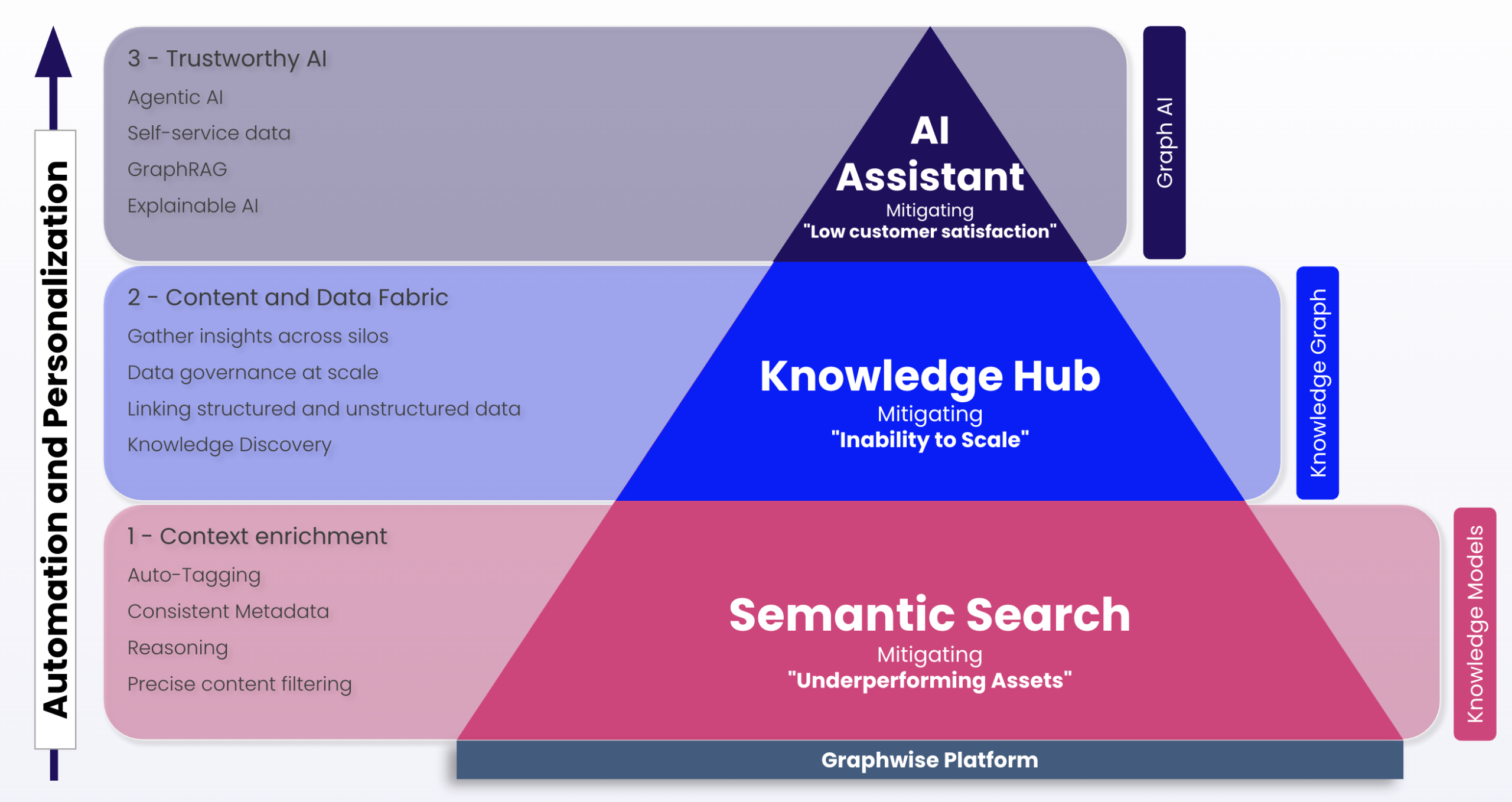
Graphwise’s solution: From data chaos to domain-aware AI
Enterprises own vast volumes of data, yet their AI applications remain vulnerable to hallucinations and pose operational risks. Building AI-ready graph environments with Graphwise resolves the risk by transforming data chaos into domain-aware graph environments.
Here is the high-level system architecture of the Graphwise platform.
- Enterprise data — Diverse multimodal data from various sources is fed into the Graphwise platform.
- Knowledge graph + Semantic layer — This raw data transforms into an enterprise knowledge graph, enriched with a semantic layer and consistent semantic metadata.
- GraphRAG & AI applications — The knowledge graph and semantic layer then support GraphRAG applications, providing the contextualized knowledge needed for LLMs to produce accurate and trustworthy outputs.

Let’s discuss the Graphwise approach to building domain-aware AI in detail.
Unified knowledge graphs to break silos
Graphwise ingests all your enterprise data into a single knowledge graph, built on GraphDB, which helps you build an enterprise data fabric. A knowledge graph maps your data as a network of entities (such as products or customers), their attributes (descriptions or properties), and their relationships (how these entities connect). This structure breaks down silos by linking data across departments and systems, giving your AI models full context to identify cross-domain connections.
GraphDB is a high-scale resource description framework (RDF) triplestore. Resource description framework stores information as triples — simple statements in the format of subject–predicate–object, such as Product X – has category – Electronics. That structure makes it easy to represent complex relationships in a machine-readable way.
Here’s how Graphwise orchestrates ingestion and integration:
- Multi-source connectors — GraphDB supports Kafka, SQL, MongoDB, CSV, XML, document imports, and Elasticsearch indexing. This means you can ingest live data streams, relational tables, and file-based sources without the need for complex ETL pipelines.
- Triples representation — Every piece of data is converted into RDF, enabling GraphDB to index and interlink data from different business units efficiently.
- Semantic inferencing — GraphDB performs reasoning based on forward chaining to infer implicit facts, such as identifying relationships between entities through shared attributes or classes, increasing the knowledge in your raw data.
- No-code UI — You can query the graph through GraphDB’s Workbench and Talk to Your Graph (TTYG) interface for visual exploration, entity navigation, and self-service querying.
Semantic AI integration for domain grounding
Graphwise embeds domain-specific ontologies and taxonomies into the graph using its graph modelling tools tailored to your industry’s terminology — whether biopharma, manufacturing, or finance. The Taxonomy Advisor helps organize these categories by suggesting structures and definitions with LLM assistance. It also proposes alternative labels based on your company’s language, adding business-semantic depth to your graph. This semantic integration ensures that AI interactions are relevant and understand the context of your industry.
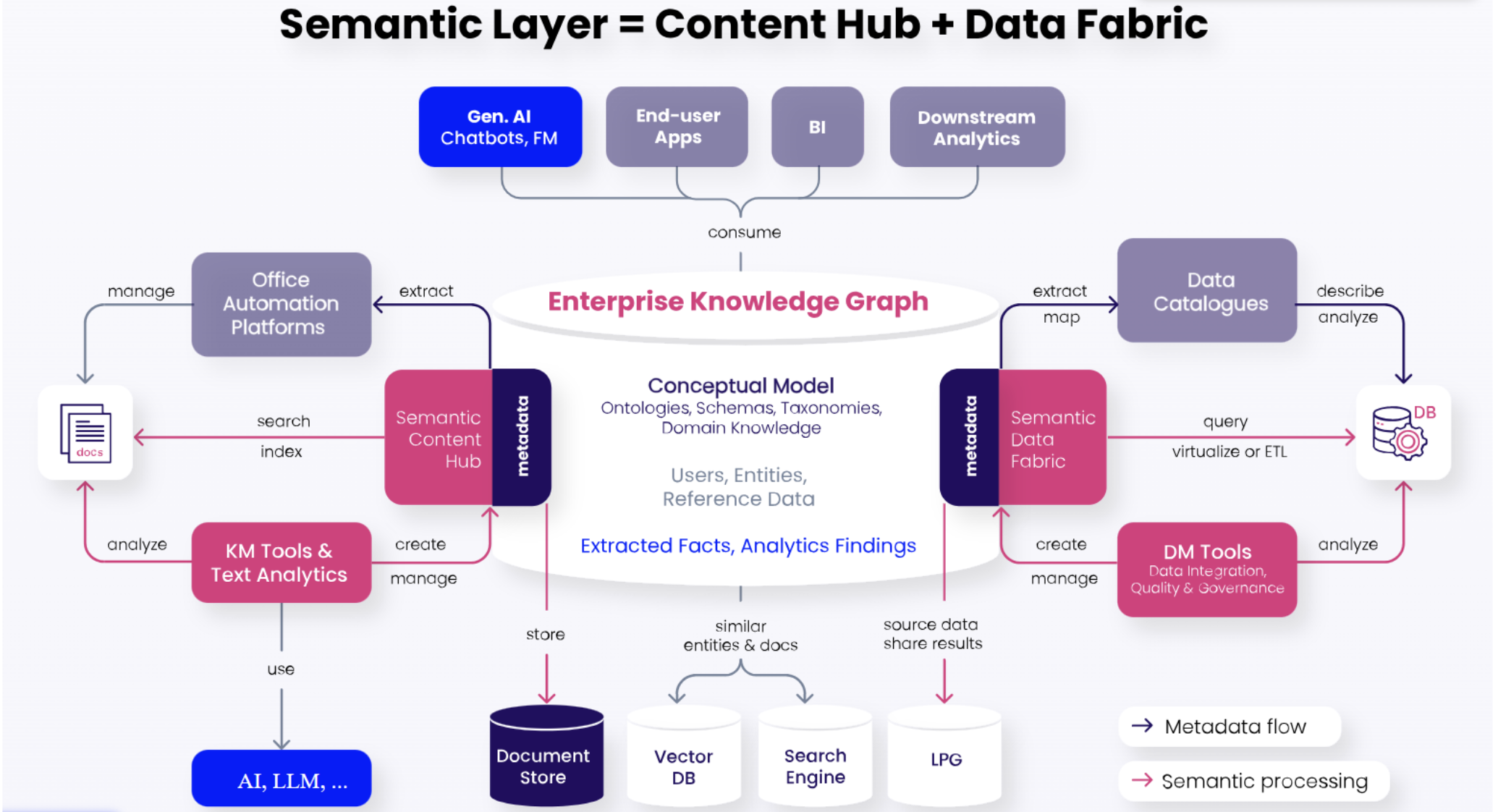
GraphRAG: Precision beyond VectorRAG and pure LLMs
Retrieval-Augmented Generation systems use vector stores to retrieve information based on semantic similarity. However, they struggle with complex, multi-hop reasoning tasks due to their lack of schema or relationship awareness.
This leads to:
- Context dilution — Embeddings retrieve similar but irrelevant chunks when domain semantics are complex.
- Low faithfulness — Models generate outputs that cannot be traced back to precise knowledge structures.
Graphwise’s GraphRAG helps you build RAG applications with up-to-date knowledge that overcomes the limitations of traditional approaches. It uses graph-aware embeddings and SPARQL-driven filtering to retrieve precise subgraphs, reducing noise in multi-step queries. GraphRAG returns connected data points — entities and their relationships — so LLMs can ground responses, overcoming hallucination and ensuring accuracy. Research shows that integrating graph-enhanced structures into Retrieval-Augmented Generation workflows improves answer precision compared to vector-based RAG (VectorRAG).
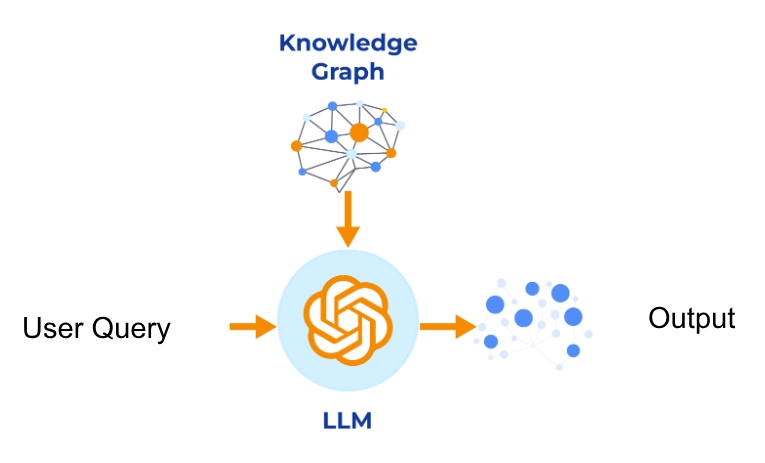
Industry success stories: Domain-aware AI in action
Graphwise’s approach is already transforming industries by enabling AI systems that are precise, trustworthy, and deeply rooted in domain knowledge.
Here are two real-world examples:
Biopharmaceuticals – Takeda case study
Biopharmaceutical companies, such as Takeda, face immense challenges in drug development, typically requiring ten years to bring a new drug to market. This lengthy process generates vast, heterogeneous volumes of data scattered across different systems and languages — some structured, some unstructured. The business problem was clear — inefficient access to millions of non-networked data records and an inability to accurately assess the relatedness or similarity of data points.
Graphwise provided the solution by enabling Takeda to build an Enterprise Data Fabric. They transformed their content and data into an AI-ready state by processing company-wide data as a structured knowledge graph. This enabled faster deployment of LLMs and scaling up to 20-30 million records. The results were transformative: automated business processes, such as submissions for authorities, and accelerated research through more efficient data access and understanding. This case study demonstrates how an intelligent data fabric can significantly reduce development cycles and enhance regulatory compliance in complex industries.
To support drug discovery, Graphwise has recently developed a method for predicting gene-disease associations. This can direct research efforts toward the most impactful areas and accelerate the drug development process. Gene-disease predictions can be integrated into Graphwise’s AI-powered Target Discovery. The product enables researchers and data scientists to collaborate in identifying new therapeutic targets and automatically validate hundreds of candidates based on custom criteria.
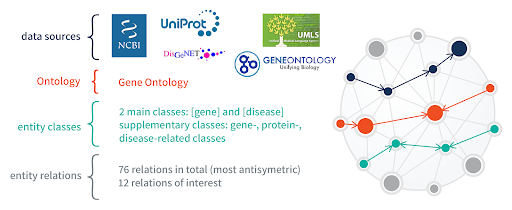
Manufacturing excellence – global troubleshooting AI
Global manufacturers often struggle with complex machinery and intricate processes, where a single fault can result in significant downtime, maintenance costs, and lost production revenue. Graphwise is helping these manufacturers with troubleshooting AI that delivers superior performance in critical operational scenarios.
Consider a scenario involving three common incidence categories: level sensors showing no reading, hydraulic pressure being too low, and the display showing a fault code for the main panel sensor.
For each, technicians need answers to questions like:
- What are the causes?
- What needs to be checked?
- What needs to be done?
- What needs to be considered (hazards)?
Through GraphRAG, Graphwise’s solution outperforms both pure LLMs and traditional VectorRAG in providing accurate answers across these categories. The AI system accurately diagnoses issues and provides maintenance guidance by leveraging relationships in a knowledge graph derived from manuals, sensor data, and records. This performance helps reduce costs through minimized downtime, optimized maintenance schedules, and enhanced operational safety. GraphRAG’s ability to manage complex operational data using knowledge models proves essential for achieving manufacturing excellence.
The future of enterprise AI: Agentic AI
Enterprises seek to leverage AI by developing more autonomous and proactive systems. This trend is moving toward Agentic AI. Graphwise is laying the foundation for this transformation. Agentic AI refers to intelligent systems that can make decisions independently and take actions to achieve specific goals without requiring constant human intervention. Such agents can operate and act reliably only if they have a clear understanding of the context of the domain, which is exactly what an AI-ready graph environment offers.
Digital twins for business – knowledge graphs as intelligent mirrors
Knowledge graphs help build digital twins — semantic representations of real-world processes and systems. These twins understand relationships, behaviors, and constraints, creating a live, evolving model of your enterprise. They integrate data from IoT sensors, operational systems, and business processes, providing a real-time view. Graph analytics, such as pathfinding, further enhance our understanding of complex system behaviors within the digital twin.
Agentic AI readiness – trustworthy, context-aware decision-making
Agentic AI leverages knowledge graphs for truth, provenance, and audit trails. These agents use graph-based retrieval ( GraphRAG) to access verified, multi-hop relationships, creating decisions rooted in explainable reasoning. This leads to the entire system becoming traceable, factual, and safe for use in domains such as healthcare and finance.
Competitive advantage – domain-aware AI competitors can’t replicate
According to Gartner, more than 40% of agentic AI projects are expected to be scrapped by the end of 2027. The main reasons are rising costs, unclear business value, and weak risk management. These issues often stem from premature hype about the technology and the misapplication of solutions. If you want to stay on the safe side, you need a graph data infrastructure that competitors cannot replicate. While competitors may replicate your AI models or technology stack, they cannot recreate your data flywheel. Your enterprise knowledge graph embodies your unique business processes and is developed over time through domain models and semantic layers, making your AI unforgeable.
Your next step: Making AI trustworthy
It is clear that AI models fail when they lack domain context, semantic grounding, and explainability. Knowledge graphs alone aren’t enough; neither are LLMs by themselves. Trustworthy AI demands a proper environment where data is connected and governed.
You can continue investing in disconnected AI tools — risking hallucinations, compliance violations, and stakeholder mistrust. Alternatively, you can evolve into an AI-ready graph environment with Graphwise and build connected intelligence, fostering trustworthy AI. This leads to faster deployment and lower costs — you reuse enriched data, reducing the time spent on model fine-tuning and retrieval tuning.
Do you want to learn more about GraphRAG for trustworthy AI?

